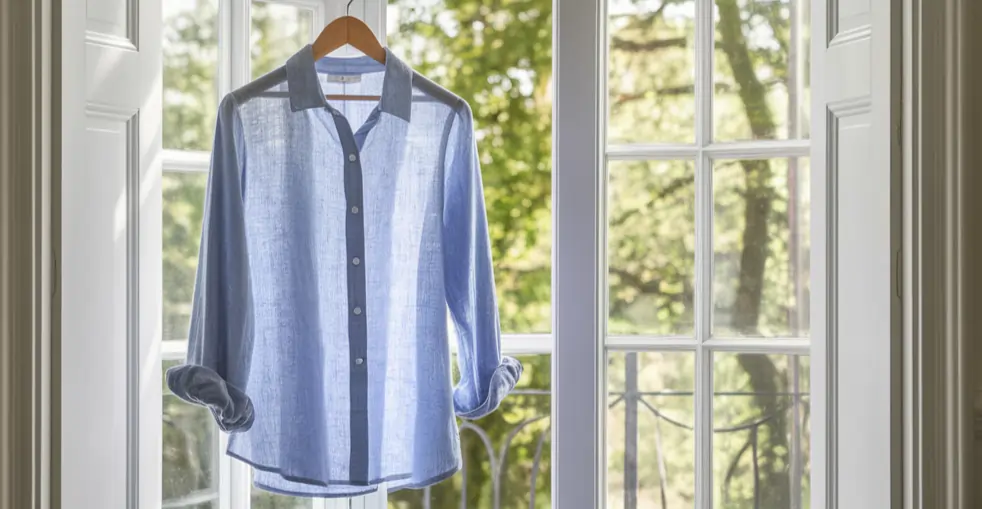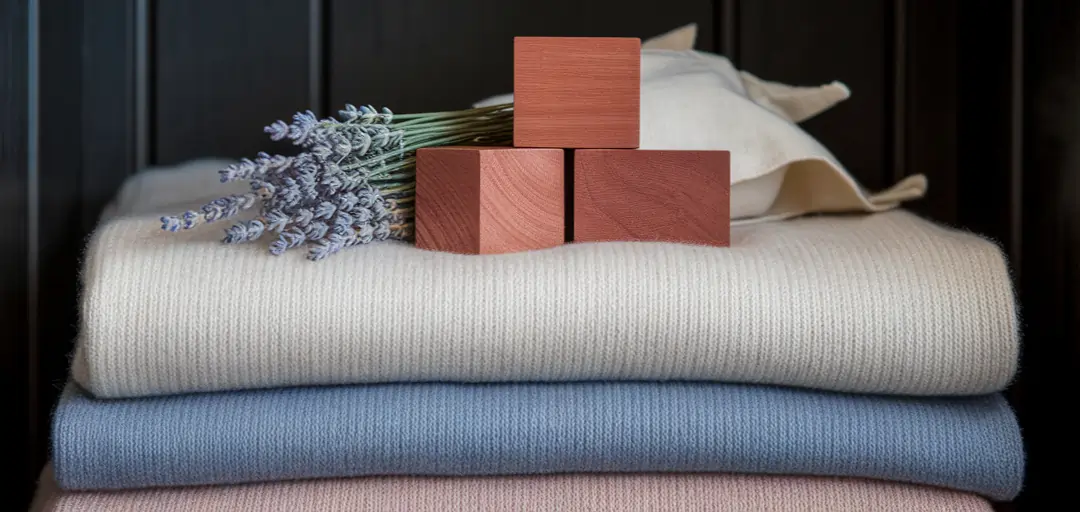Understanding the Threat in Your Wardrobe
There’s a particular kind of disappointment that comes with pulling out a favourite wool jumper as the first autumn chill sets in, only to find a tiny, unwelcome hole. This is often the first sign of the common clothes moth, Tineola bisselliella, a pest that has a taste for our most cherished garments.
It’s a common belief that the fluttery adult moths are the culprits, but the real damage is done out of sight. The adult moth you see is simply a sign of an active breeding cycle happening within your wardrobe. The true problem lies with their larvae, which have a specific appetite for natural fibres. Materials like wool, cashmere, silk, and even cotton blends are all on their menu.
What makes your clothes even more appealing are the invisible traces left behind from daily wear. Nutrients from sweat, food spills, or skin cells provide a feast for them, which is why even garments that look clean can become a target. Understanding their life cycle from egg to larva, then pupa to adult, shows why simply swatting an adult moth is not enough. A thorough strategy for protecting clothes from moths is needed to break the cycle completely and keep your wardrobe safe.
The Power of Natural Repellents

Now that we understand the source of the damage, we can explore effective ways to prevent it without resorting to harsh chemicals. The most effective wardrobe moth solutions often come from nature itself, offering protection that is both safe and pleasant for your home.
The aromatic oils in cedar wood for moths have been a trusted and effective deterrent for generations, with red cedar being especially potent. Its woody scent is pleasant to us but naturally repels moths, preventing them from settling in your storage spaces. You can create a layered defence by pairing it with other complementary scents like lavender, rosemary, and mint, which can be placed in drawers and on shelves in small sachets.
This natural approach stands in stark contrast to traditional mothballs, which often contain naphthalene or paradichlorobenzene. These chemicals work by releasing a toxic gas, which can be a concern in households with children and pets. Natural moth repellents are non-toxic, biodegradable, and leave your clothes with a fresh, clean scent rather than a lingering chemical odour. Simple additions like red cedar wood blocks are an easy way to introduce this protection. For more ideas on creating a naturally fresh and protected home, you can find further inspiration on our blog.
This table outlines the key differences to help you make an informed choice for your home and family, prioritising safety and sustainability.
Creating a Moth-Proof Storage System
With the right repellents chosen, the next step is to create an environment where moths simply cannot thrive. A secure storage system is built on cleanliness, proper containment, and smart organisation. Following these steps will turn your wardrobe into a fortress against pests.
Start with a Clean Slate
This is the single most important step. Before storing anything, especially for the season, ensure every item is washed or dry-cleaned. As agricultural experts from sources like the USDA highlight, moth larvae are drawn to soiled fabrics, so removing any trace of food, sweat, or skin cells is your first line of defence. Never put worn clothes back into a clean wardrobe.
Choose the Right Containers
Not all storage is created equal. For delicate items like suits or wool coats that need to hang, use breathable garment bags. These allow air to circulate while keeping pests out. For folded knitwear, such as cashmere jumpers and scarves, airtight containers or vacuum-sealed bags offer excellent protection, keeping them completely isolated from any potential threats.
Strategic Placement of Repellents
How you place your repellents matters. For instance, you can use our versatile red cedar wood rings directly on hangers to protect hanging garments. Scatter sachets in drawers amongst your socks and smalls, and place cedar blocks in the corners of wardrobes and storage chests. This creates a protective aroma that permeates the entire space, leaving no corner undefended.
The Importance of Airflow
Moths love cluttered, undisturbed spaces. An overstuffed wardrobe restricts airflow and creates dark, quiet corners where pests can hide and breed. A seasonal clear-out not only helps you reorganise but also disrupts potential nesting spots. It is one of the simplest yet most effective moth prevention tips.
Managing Humidity to Deter Pests

Beyond cleaning and organising, controlling the climate inside your wardrobe is another powerful tool in your moth prevention strategy. Moths and their larvae flourish in damp, still air, a common issue in many UK homes, particularly in older properties or poorly ventilated rooms. Reducing humidity makes your storage spaces far less inviting for pests.
Here are a few simple ways to lower moisture levels:
- Periodically leave wardrobe doors ajar for an hour or two to encourage air circulation.
- Consider using a small, reusable dehumidifier in the room if it feels persistently damp.
- Avoid drying laundry on radiators inside or near your wardrobe, as this releases a lot of moisture into the air.
This is where cedar wood offers a particularly intelligent advantage. Its natural properties extend beyond just repelling moths with its scent. Cedar wood also absorbs excess moisture from the air, helping to combat dampness and prevent the musty odours that often accompany it. This makes it an excellent passive wardrobe moth solution, working quietly in the background to protect your clothes. For those looking to get started, our small cedar wood bundle provides a complete set of tools to manage both pests and humidity.
Vigilance and Long-Term Wardrobe Care
Once your defences are in place, the final piece of the puzzle is consistent care and vigilance to ensure your wardrobe remains a moth-free zone. Long-term protection is not about a one-time fix but about incorporating simple habits into your routine.
Get into the habit of checking your clothes regularly, especially items you do not wear often. Look for these subtle signs of an infestation:
- Fine, silk-like webbing, often found in corners of drawers or on garments.
- Tiny holes or 'grazed' patches on the surface of fabrics where larvae have been feeding.
- Small, sand-like droppings known as frass.
Twice a year, when you switch your seasonal wardrobe, take the opportunity to empty it completely. Vacuum all the corners, shelves, and crevices, and wipe down surfaces with a natural cleaner. Here is a crucial tip for long-term success: the scent of cedar can fade over time. To maintain its effectiveness, simply give the wood a light rub with fine-grit sandpaper every few months. This releases fresh aromatic oils, a practice endorsed by pest management professionals at organisations like the National Pest Management Association who recognise cedar's lasting repellent qualities. By making these simple checks part of your routine, you can maintain lasting protection. For safeguarding your entire home, our large cedar bundle offers a comprehensive solution.










